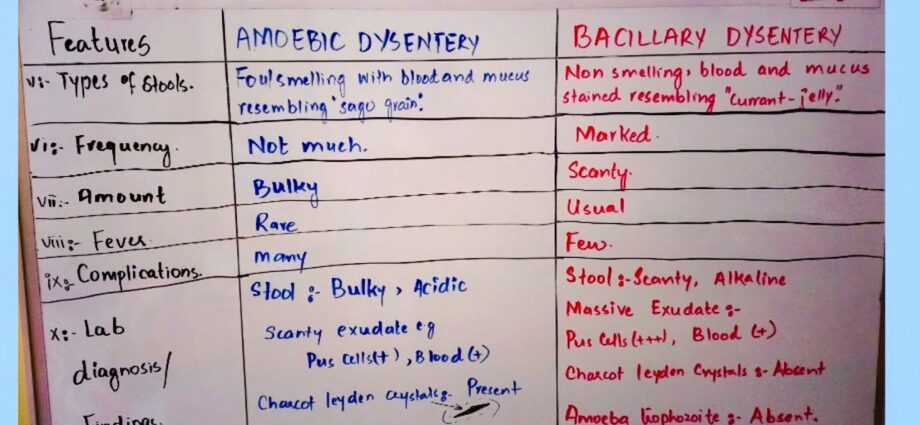Contents
Dysentery: the difference between amoebic and bacillary diarrhea
Caused by poor hygiene and even more by a lack of access to drinking water, dysentery mainly affects underdeveloped or developing countries. They can be of bacterial or parasitic origin. What are their symptoms? How to treat them? Responses from Dr Alain Weber, doctor and international consultant for emergencies in underprivileged populations.
Definition of dysentery
Dysentery is an infectious disease of the colon, causing diarrhea often associated with blood and mucus and accompanied by abdominal cramps. “This disease can be spread by ingesting contaminated food, or water that has already been contaminated with feces,” explains Dr. Weber.
The different dysenteries
There are two types of dysentery. Here are their specificities:
Bacillary dysentery
Also known as dysentery shigellosis, it is of bacterial origin. It can be caused by different bacteria, for example:
- Shigella bacillus ;
- E. Coli;
- Yersinia ;
- Amibe parasite.
The incubation period is one to four days, and symptoms last about ten days in mild infection and up to 6 weeks in severe disease.
The particular case of shigellosis
“Shigellosis is more common in children than in adults. Children aged 1 to 4 are particularly affected, especially in an area where sanitation is insufficient or when there is an epidemic of the disease. Says Dr Weber.
Amoebic dysentery
Also called amoebiasis, amoebic dysentery is caused by a protozoan parasite known asEntamoeba histolytica. “This parasite affects both the small intestines and the large intestines and is spread mainly through feces” describes the doctor.
This infection is common in developing countries, where drinking water is difficult to access.
Causes of dysentery
Whether amoebic or bacillary, dysentery is always caused by:
- poor hygiene;
- by a lack of access to drinking water.
“People with dysentery have ingested fecal matter through water or food,” says Dr Weber, “and unlike amoebic dysentery which is spread mainly through contamination of food or drink, shigellosis can be acquired from close contact with infected persons ”.
Bacterial dysentery can indeed be contracted in a home, daycare center or nursing home.
Symptoms of dysentery
The symptoms of dysentery can be more or less severe depending on the spread of the infection but also depending on the quality of water sanitation in the area.
“In developed countries, symptoms of dysentery can be mild and easily treated, and conversely, in developing countries, signs and symptoms tend to be more severe,” explains the doctor.
Symptoms of bacillary dysentery
In bacillary dysentery, symptoms start between 1 and 3 days after infection.
They are most often:
- stomach pain which can lead to severe abdominal pain;
- diarrhea, whether or not associated with blood and mucus;
- nausea and vomiting;
- mild to severe fever;
- fatigue and general weakness.
“Sometimes the symptoms are very mild and can go away on their own without treatment. But in the presence of vomiting and blood or mucus in the stool, it is imperative to consult a doctor ”insists Dr. Weber.
Symptoms of amoebic dysentery
In case of amoebic dysentery, the symptoms are most often:
- severe pain in the abdominal area;
- feeling cold and feverish;
- vomiting and nausea;
- dizziness ;
- watery diarrhea which may contain blood and / or mucus;
- pain when passing stool;
- constipation that occurs intermittently;
- tiredness.
This amoebic dysentery can cause complications caused by the parasite “it can in some cases cause a gastric or duodenal ulcer, because the amoeba can live in the intestinal walls without control” explains Dr. Weber.
If the parasite is able to make its way into the bloodstream, it can infect the liver and cause abscesses, which can be very serious or even fatal.
Diagnosis of dysentery
In case of symptoms, to confirm the diagnosis and especially to offer the right treatment, it is essential to determine the cause of the dysentery. For this, a stool analysis – called a stool culture – is performed. It makes it possible to analyze the bacteria or parasites responsible for the infection.
Treatment of dysentery
Treatment of amoebic dysentery
If the dysentery is amoebic: it is treated by taking broad-spectrum antiparasitics and contact amoebicides which act locally in the digestive tract.
Treatment of bacterial dysentery
If the dysentery is of bacterial origin: it is treated with antibiotics, depending on the bacteria found in the stool.
Prevention of dysentery
“Dysentery is one of the three deadliest in the world, nearly 4 million deaths including more than 500.000 children. All this with the main cause being the lack of access to drinking water, ”insists Dr Weber, who campaigns for the search for solutions concerning access to drinking water. In particular, the doctor proposes the installation of mobile water purification machines that run on solar energy.
The prevention of dysentery is also based on general hygiene and food measures:
- Wash hands thoroughly with soap and water, or with a hydro-alcoholic solution, especially before meals and after going to the toilet;
- Wash, peel and / or cook food before eating it;
- Avoid raw vegetables;
- Boil the water before consuming it.










